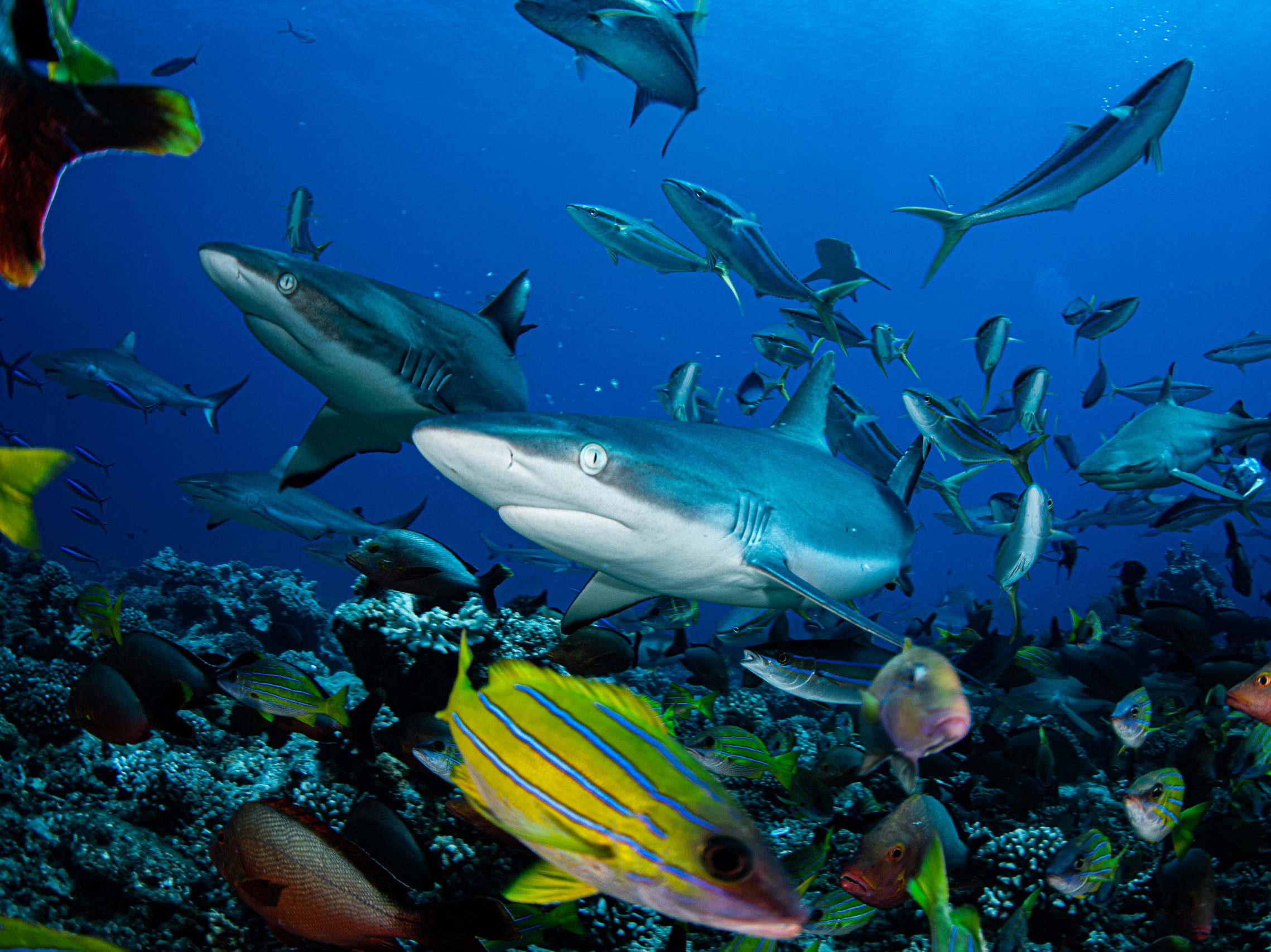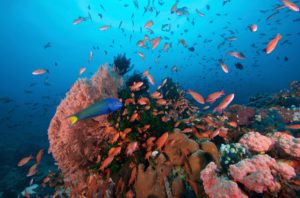When world leaders come together for the 15th meeting of the Conference of the Parties (COP) to the Convention on Biological Diversity, postponed from earlier this year and now set to take place in Kunming, China, in May 2021, Brian O’Donnell, executive director of the Campaign for Nature, wants to make sure they bring their 30×30 commitments.
Our Shared Seas sat down with Brian to learn more about this effort, and what it means for our ocean. In this interview, he provides insights on the state of play on the post-2020 framework negotiations process and what needs to happen between now and next year’s COP to achieve a target of 30 percent ocean protection by 2030.

Photo: Kimberly Jeffries / Coral Reef Image Bank
Can you talk about the pathways for achieving 30×30 for ocean protection? We have currently protected 5.7 to 7.5 percent of the global ocean (based on differences in accounting). What elements need to be in place to increase to 30 percent protection of the ocean in less than a decade?
First of all, when we talk about the 30×30 campaign, the ocean component is the bigger lift because ocean conservation has lagged, even though our ocean is, many would argue, the most important part of our planet. Having only that range of 5.7 to 7.5 percent protected, depending on how you count, shows that we have an ambitious lift to make in 10 years. It’s going to be an incredible challenge on several fronts.
We need at least two high-level actions: target setting in the Convention on Biological Diversity (CBD) and a global treaty on areas beyond national jurisdiction. Putting those high-level structures in place is the first big thing we can do. Then we need to recapture the momentum we had before the pandemic to keep these efforts going.
To make this happen, we must come together as a society and through the Convention on Biological Diversity set that level of ambition collectively. The CBD is really the only avenue we have to come together for a major global biodiversity agreement that has a framework in place and that has the respect of the nations. We have seen that nations do take these targets seriously. If you look at Canada in recent years and its increase in both marine and terrestrial protected areas, it was really just to meet global targets in response to the Aichi Biodiversity Targets. That’s what drove that kind of urgency. And so the first step is to create this urgency.
We also need a treaty for the biological diversity of marine areas beyond national jurisdiction (BBNJ) as a mechanism to create MPAs on the high seas. This treaty will provide the critical process needed for countries to come together to protect the high seas with a legally binding instrument.
We have seen that nations do take these targets seriously. If you look at Canada in recent years and its increase in both marine and terrestrial protected areas, it was really just to meet global targets in response to the Aichi Biodiversity Targets. And so the first step is to create this urgency.
What is the role for stakeholders across sectors – government, civil society, and research – to support the pathway to 30×30?

Related article: A Primer on Climate Change and Marine Biodiversity Photo: Jayne Jenkins / Coral Reef Image Bank
For governments, we need to promote healthy competition among nations. We started to see this a few years ago with the announcements of the world’s largest MPAs. There was the ocean conference where President Obama announced a large marine monument in Hawaii, and then France made a commitment days later. Several Pacific islands also announced huge marine protected areas around the same time. That sort of “race to biodiversity conservation of ambition” represented a healthy competition that the world needs to continue. Who can be the leading nation for the world’s ocean? How do we inspire that healthy competition? I think the UK is looking at that opportunity right now with its Global Ocean Alliance. All of us who care about the ocean should work to get countries to join that effort.
And then there’s the part that NGOs and academics are good at. But we need to redouble our efforts to develop and promote the science in a compelling way to show which places are critical for biodiversity. We must demonstrate to countries that MPAs, if managed properly, do meet their goals – then show them what it means to be managed properly. We need to show how properly managed MPAs can lead to a greater abundance of fish over time.
NGOs and the research community can also elevate the nexus between carbon and the ocean, which has become increasingly clearer in recent years. There’s a huge new climate argument for ocean conservation. We need to get this information out to government leaders who often prioritize climate change policy over biodiversity protection. We have a chance to piggyback on that conservation agenda.
That sort of “race to biodiversity conservation of ambition” represented a healthy competition that the world needs to continue. Who can be the leading nation for the world’s ocean? How do we inspire that healthy competition?
We are currently seven months out from the global biodiversity meeting in Kunming, set to take place in May 2021. Can you describe what the road to the CBD Conference of the Parties may look like: how do get from here to a successful outcome next year? Is there a strong likelihood of an ambitious target for global marine protection?
A few things need to happen. There is an expectation from many lower-income countries that increasing resources must accompany any ambitious deal and we’re not yet on track for that. There has been a push for a big new global biodiversity fund. I don’t think there’s appetite for that from donor countries. But showing that there are, in fact, resources streaming in is essential to reach a deal.
China has held its cards very close on its position. They’ve shown the terrestrial 30 percent target is something that they seem willing to go along with. In recent media reports, they have stated that they’re still looking at the marine target and exploring whether it can be achieved (in their words). We have some work to do to show China that they can reach that target and need to lead on this work as the host nation. (Editor’s note: On September 22, China pledged that it would aim for its carbon dioxide emissions to peak before 2030 and to achieve carbon neutrality before 2060.)
There is still potential to show Indigenous people and local communities how 30×30 provides a huge opportunity for them to have more say over their lands and territories. The jury is out on whether the Convention on Biological Diversity and civil society will engage with Indigenous people and local communities in a collaborative way. If that happens, it will be a huge win.
I’m optimistic that momentum is building every day. When you look at how quickly nations have organized into a High Ambition Coalition for Nature and People and the UK Oceans Alliance, you realize some of the world’s most mega biodiverse countries are on board. Some of the largest donor countries and some huge political players in the CBD are also on board. People recognize between Covid-19, the climate crisis, and all these recent reports about the loss of species abundance, there is unprecedented urgency. The beauty of the 30×30 campaign is that it is an open campaign with hundreds of organizations and communities leading it. For all these reasons, I am optimistic that we are going to succeed in 2021. The biggest challenge will be continuing the momentum in the decade afterwards to make sure these areas get designated and funded, are implemented equitably, and achieve biodiversity outcomes.
I am optimistic that we are going to succeed in 2021. The biggest challenge will be continuing the momentum in the decade afterwards to make sure these areas get designated and funded, are implemented equitably, and achieve biodiversity outcomes.
Can you provide a level set on 30×30 in terms of current ambition and how it may be impacted by Covid-19? Do governments have bandwidth to think about ocean protection while most countries right now are cash strapped and working to fight a pandemic? Or, are countries acting with newfound urgency?
There are two camps on this. The first is a short-sighted one that wants to get the world back as it was as quickly as possible by injecting economies with stimulus that bring us back to massive consumption-based economies that were already heading for disaster before the pandemic started.
The second camp has seen the vulnerability that we are facing from Covid-19, combined with the radically increased impacts of climate change that we’ve seen in recent months. As the entire world basically shut down because of a virus, we realized that nature is the engineer on this planet and we need to respect its boundaries.
Either way, we need to stimulate the economy and help people who are who are in desperate straits because of Covid-19 and lost livelihoods. The question then becomes, which way do we do that? Do we return to a system that is that is inherently headed to a train wreck? Or do we build a new approach that features safeguards to address biodiversity, climate impacts, and the livelihoods of those who are most vulnerable in the world? We are currently seeing a mixed reaction on that.
Many countries are talking the talk, but when you look at the actual numbers in stimulus bills, few countries are putting resources into in the kind of “build back better” approach that is desperately needed. We have countries spending tremendous amounts of money to restart their economies, but in a matter of months to a year, we’ll be in a position where these countries have been saddled with quite a bit of debt. Then we risk being in a position where they’ll say they have no money to finance biodiversity conservation.
On a more positive note, I think that the UK hosting the Climate Change Conference (COP26) in November 2021 is important because there’s an emerging alignment between climate and biodiversity. The fact that China is hosting the CBD Conference and the UK is hosting the Climate COP requires both of those countries to work together. I’m optimistic to see stakeholders pushing to achieve alignment and progress on climate and biodiversity together.
The fact that China is hosting the CBD Conference and the UK is hosting the Climate COP requires both of those countries to work together. I’m optimistic to see stakeholders pushing to achieve alignment and progress on climate and biodiversity together.
The Campaign for Nature is committed to integrating the leadership of Indigenous peoples and local communities in all 30 percent protection scenarios. Achieving 30×30 in less than 10 years will require swift action across a variety of stakeholders. How can governments, philanthropy, NGOs, and other actors honor that commitment in designating and implementing MPAs at scale in the coming years?
The top priority is to engage communities early. Too often, we engage Indigenous and local communities late in the process. When we are thinking about areas of high biodiversity, we need to have discussions with those on the ground at the very beginning. Who are the people who live there and have a stake in its protection? Places with the highest remaining biodiversity generally have that remaining biodiversity because the local people have figured out a way to live closer in harmony and sustainably than others.
Some structural issues are hugely challenging. The Convention on Biological Diversity itself empowers countries and this structure works well for those countries that advocate for indigenous leadership. However, because Indigenous people themselves are not parties, they are systematically excluded from the CBD discussion. Countries need to provide a greater role to Indigenous people in the formal negotiations process. When each country prepares its National Biodiversity Strategic Action Plan for its 30 percent target, we should require from the outset that governments include consultation and engagement with Indigenous people.
We need a significant increase in philanthropy in this area if we’re going to have a truly equitable engagement with indigenous local communities.
Places with the highest remaining biodiversity generally have that remaining biodiversity because the local people have figured out a way to live closer in harmony and sustainably than others.
Let’s pretend it’s the year 2030 and the world has achieved 30 percent protection of the ocean and land. What would this look like to you? Do you have any words of caution on how the conservation community can achieve both quality and quantity to avoid the phenomenon of ‘paper parks’, meaning protected areas that exist primarily on paper and may lack adequate protection, funding, or community support?
As we gain momentum on a 30 percent target, we must ensure that we are protecting places that are most important for biodiversity by putting an increased focus and pressure on the quality of protected areas. There’s a balance between being inclusive and making sure that there’s a strong biodiversity outcome embedded in the target. Many people would like to call an area protected or conserved that allows for industrial activities that harm biodiversity. For both ocean and land protection, we tend to start with areas that people think are low-hanging fruit or have no conflicts in resource use. If there are zero conflicts with industrial fishing, seabed mining, or other industrial activities, then we’re probably not doing a whole lot of conservation there.
We are also in real danger of advancing a percentage target without adequate finance right now. An estimated 85 percent of the 30×30 campaign is supporting entities that are pushing the target and focused on policy, with maybe 15 percent on the finance side. We need to flip that ratio.
Lastly, Covid-19 has caused a delay. We had a lot of momentum building for the 30×30 campaign. Between the UN Biodiversity Summit on September 30 and the meeting in China next May, there will not be another major dialogue of the Convention on Biological Diversity at a high level. We are all working diligently towards the May meeting, and we must maintain momentum over the coming months.
We are in real danger of advancing a percentage target without adequate finance right now. An estimated 85 percent of the 30×30 campaign is supporting entities that are pushing the target and focused on policy, with maybe 15 percent on the finance side. We need to flip that ratio.
Read our follow-up interview with Brian O’Donnell here for a list of tangible actions that the marine conservation community can take to help secure an ambitious global deal for ocean protection in 2021.



